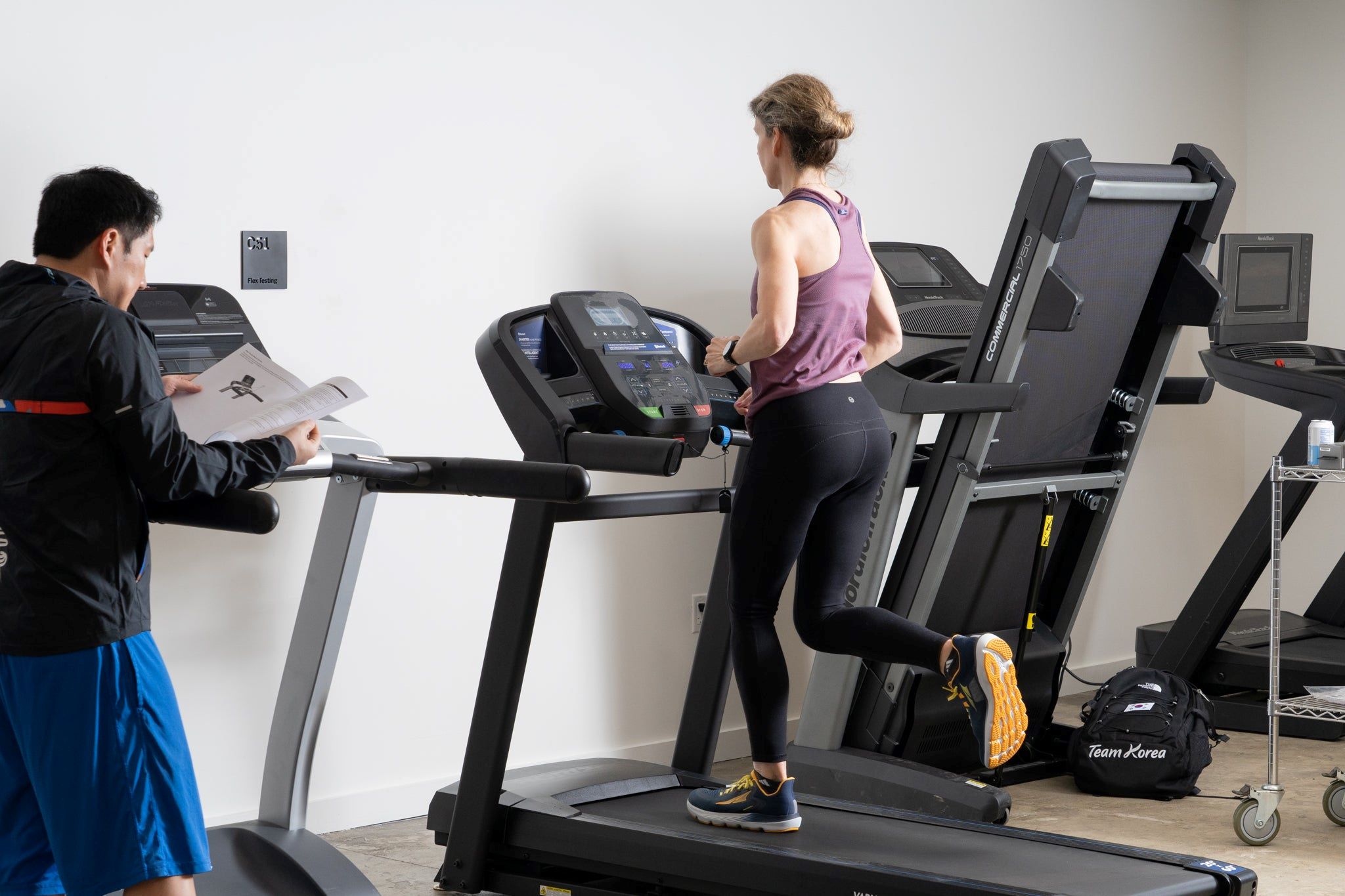

Featured
How To Step Distance Running
Modified: August 21, 2023
Learn how to step up your distance running game with our featured tips and techniques. Maximize your endurance and achieve your running goals effortlessly.
Introduction
Distance running is a popular form of exercise and a great way to improve cardiovascular fitness and overall health. Whether you’re a beginner looking to start a running routine or an experienced runner aiming to improve your performance, this article is here to guide you with valuable tips and techniques.
Running offers a plethora of benefits, including weight loss, stress reduction, increased stamina, and improved mental well-being. However, it is essential to approach distance running with the right mindset and preparation to ensure a safe and successful journey.
In this article, we will discuss various aspects of distance running, including choosing the right running shoes, warm-up exercises, building endurance, proper breathing techniques, maintaining good running form, hydration and nutrition tips, setting realistic goals, and the importance of rest and recovery. Additionally, we will explore strategies for staying motivated and mentally prepared to maximize your running potential.
Whether your goal is to complete your first 5K race or conquer a marathon, this guide will provide you with the necessary knowledge and strategies to excel in distance running. So, lace up your running shoes and let’s embark on this exciting journey together!
Choosing the Right Running Shoes
When it comes to distance running, having the right pair of running shoes is crucial. The perfect pair can provide the necessary support, cushioning, and stability for your feet, helping to prevent injuries and enhance your overall running experience.
There are several factors to consider when selecting running shoes:
- Foot Type: Determine your foot type, whether you have high arches, flat feet, or a neutral arch. This will help you choose shoes with the appropriate level of support.
- Shoe Cushioning: Consider the level of cushioning you prefer. Some runners prefer more cushioning for shock absorption, while others prefer a firmer feel for a more responsive ride.
- Shoe Size: Ensure that you choose the correct shoe size that provides enough space for your toes to wiggle without being too loose or too tight.
- Shoe Weight: Decide whether you prefer lightweight shoes for speed or more substantial shoes for added stability.
- Running Terrain: Consider the terrain you will be primarily running on—road, trail, or a combination. This will help determine the appropriate shoe type, such as road running shoes or trail running shoes with more traction.
To find the ideal pair, it is recommended to visit a specialty running store where experts can analyze your running gait and provide personalized advice. They may perform a gait analysis, examining how your feet and legs move while running, to help determine the right type of shoe for you.
Remember, investing in a good pair of running shoes is essential to avoid discomfort, blisters, and potential long-term injuries. Additionally, make sure to replace your running shoes every 300-500 miles or when you start to notice signs of wear and tear.
By selecting the right running shoes, you will provide your feet with the support and comfort they need to perform optimally. So, take the time to research, try on different options, and seek professional advice to find the perfect pair for your running needs.
Warm-Up and Stretching
Before embarking on your distance running journey, it is crucial to prepare your body for the physical demands ahead. Warm-up exercises and proper stretching can help prevent injuries and optimize your performance during the run.
A dynamic warm-up routine is a great way to get your muscles warmed up and ready for action. This should include exercises that target the major muscle groups used in running, such as legs, hips, and core. Some beneficial warm-up exercises include lunges, high knees, butt kicks, leg swings, and arm circles.
After warming up, it’s time to stretch. Dynamic stretching, which involves controlled movements through a full range of motion, is ideal before a run. This helps improve flexibility, increase blood flow, and enhance joint mobility. Examples of dynamic stretches include walking lunges, leg swings, and torso twists.
It is important to note that static stretching, where you hold a stretch for an extended period, is more suitable for post-run or cooldown. These stretches help improve muscle flexibility, reduce muscle soreness, and aid in preventing muscle imbalances.
Incorporate stretches that target the major muscle groups used in running, such as hamstrings, quadriceps, calves, and hip flexors. Some effective static stretches include standing hamstring stretch, quadriceps stretch, calf stretch, and hip flexor stretch.
Remember, do not rush through your warm-up and stretching routine. Take your time and focus on proper form and technique. It is better to spend a few extra minutes preparing your body adequately than to risk injury or poor performance during your run.
Also, listen to your body. If you feel any pain or discomfort while stretching, adjust or modify the stretch to avoid any strain. Everyone’s body is unique, so find stretches that work best for you and your specific needs.
By incorporating a thorough warm-up and stretching routine into your distance running routine, you will improve blood circulation, increase flexibility, and reduce the risk of injury. So, before you hit the pavement or trail, take the time to warm up your body and stretch those muscles!
Building Endurance
Building endurance is a key component of distance running. It allows you to maintain a steady pace over prolonged periods and tackle longer distances with ease. Whether you’re a beginner or an experienced runner, there are various strategies you can implement to improve your endurance.
Consistency is key when it comes to building endurance. Gradually increase your running mileage and duration over time. It is important to listen to your body and avoid overexertion to prevent injuries. Aim for incremental increases, such as adding an extra mile to your long run each week, to allow your body to adapt to the increased demands.
Incorporating interval training into your routine can also help build endurance. This involves alternating between high-intensity efforts and recovery periods. For example, try adding short bursts of sprinting or fast-paced running followed by a period of slower jogging or walking. Interval training helps push your cardiovascular system, improves your lung capacity, and enhances your body’s ability to utilize oxygen efficiently.
To avoid hitting a plateau in your training, it is essential to introduce variety. Include different types of runs in your routine, such as tempo runs, hill repeats, and long slow distance (LSD) runs. This not only keeps your training interesting but also challenges your body in different ways, helping to build endurance and overall fitness.
Don’t forget about cross-training! Incorporate activities such as swimming, cycling, or strength training into your routine. Cross-training engages different muscle groups and provides a break from the repetitive nature of running, reducing the risk of overuse injuries. It also contributes to overall fitness and can enhance your endurance capabilities.
Proper pacing during your runs is essential for building endurance. Avoid starting too fast and burning out quickly. Instead, maintain a comfortable and sustainable pace throughout your run. Learning how to control your breathing and find a rhythm that works for you can greatly improve your endurance and running efficiency.
Lastly, rest and recovery are crucial components of building endurance. Allow your body time to adapt and repair itself after intense workouts. Overtraining can lead to fatigue, decreased performance, and an increased risk of injury. Incorporate rest days into your training schedule and prioritize getting enough sleep to support proper recovery.
Remember, building endurance takes time and patience. It is a gradual process that requires consistency, variety, proper pacing, and adequate rest. Keep pushing yourself, stay motivated, and celebrate your progress along the way. With dedication and perseverance, you will develop the endurance needed to conquer any distance.
Proper Breathing Techniques
Proper breathing techniques are essential for distance runners. They not only provide the necessary oxygen to fuel your muscles but also help maintain a steady rhythm and reduce fatigue during your runs. By focusing on your breathing, you can optimize your performance and enhance your overall running experience.
One of the key aspects of proper breathing is to breathe deeply from your diaphragm rather than shallowly from your chest. This allows for a more efficient exchange of oxygen and carbon dioxide in your lungs. Practice belly breathing by inhaling deeply through your nose, filling your abdomen with air, and then exhaling slowly through your mouth.
Syncing your breath with your running rhythm is also important. Find a breathing pattern that works for you based on your pace and the intensity of your run. Many runners find it helpful to use a 3:2 or a 2:2 breathing ratio. For example, inhale for three steps and exhale for two steps, or inhale for two steps and exhale for two steps. Experiment with different patterns to find what feels most comfortable and natural for you.
It’s common for runners to experience side stitches or cramps, which can be triggered by poor breathing techniques. If you feel a side stitch coming on, try deepening your breath and exhaling forcefully as you land on the opposite foot. This can help alleviate the discomfort and prevent further stitches.
Maintaining relaxed and steady breathing throughout your run is crucial. Avoid holding your breath or tensing your upper body, as this can lead to decreased oxygen flow and unnecessary fatigue. Stay mindful of your breathing, especially during challenging moments, and consciously relax your muscles.
Inhale and exhale through both your nose and mouth. Breathing through your nose helps filter the air and slightly warms it before it reaches your lungs. However, during intense runs, it may not provide enough oxygen, so it’s important to allow for mouth breathing as needed.
Focus on your breathing technique during your training runs to develop a natural and efficient rhythm that works for you. Pay attention to how different breathing patterns affect your energy levels, endurance, and overall running performance. It may take some time to find the optimal technique, but with practice, it will become second nature.
Remember, breathing properly and staying mindful of your breath can help you stay relaxed, perform better, and enjoy your distance running experience to the fullest. So, take a deep breath, find your rhythm, and let your breath guide you through the miles ahead.
Maintaining a Good Running Form
Maintaining a good running form is essential for maximizing efficiency, preventing injuries, and improving overall performance. By focusing on proper posture and technique, you can optimize your stride and make your runs smoother and more enjoyable.
Here are some key aspects to consider when it comes to maintaining a good running form:
- Posture: Keep your head up, eyes forward, and shoulders relaxed. Avoid slouching or hunching your back. Engage your core muscles to support your upper body and maintain a straight alignment from your head to your hips.
- Arms: Maintain a relaxed arm swing, with your elbows bent at a 90-degree angle. Avoid excessive movements and swinging your arms across your body. Your arms should move in a forward and backward motion, helping to balance out your stride.
- Stride: Stride length and frequency play important roles in your running form. Aim for a moderate stride length—not too short that it causes an inefficient shuffle, and not too long that it strains your muscles. Increase your stride length naturally by focusing on pushing off from your toes and driving your knee forward.
- Cadence: Cadence refers to the number of steps you take per minute. Aim for a cadence of around 170-180 steps per minute. Higher cadence helps reduce overstriding and puts less stress on your joints, improving overall efficiency.
- Footstrike: Focus on a midfoot or forefoot strike rather than landing on your heel. This allows for a more efficient transfer of energy and reduces the impact on your joints. Aim for a light and quick landing, rolling smoothly from heel to toe.
- Breathing: Maintain a steady and controlled breathing rhythm as discussed in the previous section. Focus on deep diaphragmatic breaths to fuel your muscles with oxygen while maintaining a relaxed upper body.
Video analysis of your running form can be helpful in identifying any areas that require improvement. Online resources or working with a running coach can provide valuable guidance in assessing and correcting your form.
Keep in mind that adjusting your running form takes time and practice. Start by focusing on one or two aspects at a time during your training runs. Gradually integrate the adjustments until they become second nature.
Consistency is key. Regularly check in with your running form, especially during long runs or periods of fatigue. It’s common for form to deteriorate as you become fatigued, so staying mindful and actively trying to maintain good form throughout your run is essential.
By maintaining a good running form, you minimize the risk of injury, optimize your energy efficiency, and enhance your overall running performance. So, incorporate these tips into your training routine, stay mindful of your form, and enjoy the benefits of a strong and efficient stride.
Hydration and Nutrition Tips
Proper hydration and nutrition are essential components of successful distance running. They fuel your body, optimize performance, and aid in recovery. Implementing the following tips will help you stay hydrated and nourished during your runs:
Hydration:
- Drink water regularly throughout the day, not just during your runs. Staying well-hydrated is crucial for optimal performance.
- Before a run, aim to consume around 16-20 ounces (450-600 ml) of water 2-3 hours beforehand to ensure proper hydration.
- During your runs, carry a water bottle or plan your route near water sources. Aim to sip water every 15-20 minutes to prevent dehydration.
- In hot and humid conditions, consider electrolyte-replenishing drinks or sports drinks that provide essential electrolytes lost through sweat.
- Pay attention to your body’s signals for thirst and adjust your hydration accordingly. Everyone’s fluid needs may vary, so it’s important to listen to your body.
Nutrition:
- Ensure you have a balanced diet rich in carbohydrates, protein, and healthy fats to support your training.
- Prioritize complex carbohydrates such as whole grains, fruits, and vegetables, which provide sustained energy for distance running.
- Consume a balanced meal 2-3 hours before your runs to fuel your body adequately. Include carbohydrates for energy and a moderate amount of protein for muscle repair and recovery.
- For runs lasting longer than an hour, consider refueling with a light snack or energy gel to replenish glycogen stores and provide a quick source of energy.
- After your runs, prioritize post-workout nutrition by consuming a combination of carbohydrates and protein within 30-60 minutes to kickstart muscle recovery.
- Experiment with different types of fueling options during your long runs, such as energy gels, sports drinks, or real food. Find what works best for your stomach and provides the necessary energy without causing discomfort.
Keep in mind that hydration and nutrition are individualized, so take the time to understand your body’s needs through trial and error. What works for one runner may not work for another.
Monitor your hydration levels by paying attention to the color of your urine. Light and pale yellow urine indicates adequate hydration, while dark urine suggests dehydration.
Additionally, consult with a registered dietitian or sports nutritionist for personalized guidance and recommendations based on your specific training goals and dietary needs.
By prioritizing hydration and nutrition, you will optimize your energy levels, ward off fatigue, and improve your overall performance in distance running. So, hydrate well, nourish your body properly, and enjoy the benefits of a well-fueled journey!
Setting Realistic Goals
Setting realistic goals is an essential aspect of distance running. Having clear objectives not only keeps you focused and motivated but also helps track your progress and celebrate your achievements. Here are some tips for setting realistic goals in your running journey:
Assess Your Current Fitness Level:
Take an honest assessment of your current fitness level and running abilities. Consider factors such as your current pace, the distance you can comfortably run, and your overall endurance. This will provide a baseline to gauge your progress and set appropriate goals.
Be Specific and Measurable:
Create specific goals that you can measure to track your progress. For example, instead of setting a general goal to “improve endurance,” consider setting a specific target such as completing a 10K race or running continuously for 30 minutes without stopping.
Set Short-term and Long-term Goals:
Break down your journey into short-term and long-term goals. Short-term goals should be achievable in the near future, such as increasing weekly mileage or improving your pace by a certain amount. Long-term goals should be more ambitious, such as completing a half marathon or qualifying for a competitive race.
Make Goals Challenging but Attainable:
Push yourself outside your comfort zone, but ensure that your goals are achievable. Setting goals that are unrealistic or too difficult to reach can lead to frustration and disappointment. Gradually increase the difficulty level as you progress and build confidence.
Set Time-based Goals:
Include timelines or deadlines for your goals. This helps create a sense of accountability and urgency. For example, setting a goal to run a 5K race in three months allows you to structure your training and monitor your progress leading up to the event.
Consider External Factors:
Take into consideration external factors such as work commitments, family obligations, and other responsibilities. Ensure that your goals align with your current lifestyle and are realistic given your available time and resources.
Celebrate Milestones:
Don’t forget to celebrate your achievements along the way. Recognize and reward yourself when you successfully reach a goal or milestone. This keeps you motivated and adds a sense of accomplishment to your running journey.
Be Flexible:
Be open to adjusting your goals if necessary. Life events or unexpected circumstances may arise that require adapting your running plans. Be flexible and willing to modify your goals without feeling discouraged.
Remember, goal setting is a personal process. What works for one person may not work for another. Tailor your goals to your own abilities, aspirations, and interests. Maintain a positive mindset, stay focused, and enjoy the journey as you progress toward your running goals.
Rest and Recovery
Rest and recovery are essential components of distance running. Many runners overlook the importance of allowing their bodies to rest and repair, but it is during this phase that improvements are made, and injury risks are minimized. Here are some key considerations when it comes to rest and recovery:
Rest Days:
Integrate rest days into your training schedule. These are days dedicated to complete rest or low-impact activities to allow your body to recover. Rest days give your muscles and connective tissues time to repair and rebuild, which enhances performance and reduces the risk of overuse injuries.
Quality Sleep:
Make sleep a priority. Aim for 7-9 hours of quality sleep each night. Sleep is when your body repairs and rejuvenates itself, leading to better muscle recovery, enhanced cognitive function, and improved overall well-being. Create a sleep routine and establish a conducive sleep environment to optimize your sleep quality.
Nutrition:
Proper nutrition plays a vital role in recovery. Consume a balanced diet rich in nutrients to support muscle repair and replenishment of energy stores. Include a combination of carbohydrates, proteins, and healthy fats in your meals. Additionally, incorporate post-workout nutrition within 30-60 minutes after your runs to refuel your muscles and aid in recovery.
Active Recovery:
Engage in activities that promote active recovery, such as gentle stretching, yoga, or low-impact exercises. These activities increase blood circulation, reduce muscle soreness, and help loosen tight muscles. Active recovery can also include activities unrelated to running, such as swimming or cycling, to give your running muscles a break while still maintaining cardiovascular fitness.
Listen to Your Body:
Pay attention to your body’s signals and adjust your training accordingly. If you feel excessively fatigued, experience persistent pain, or notice a decline in performance, it may be a sign that you need additional rest or recovery. Be proactive in addressing any discomfort or potential injuries to prevent them from worsening.
Cross-Training:
Incorporate cross-training activities into your routine. Engaging in activities other than running, such as strength training, cycling, or swimming, helps strengthen different muscle groups, prevent muscle imbalances, and provide a mental break from running. Cross-training also allows you to maintain fitness levels while giving specific running muscles time to recover.
Reduce Stress:
Manage stress levels as it can impact your recovery. High levels of stress can lead to increased muscle tension and delayed recovery. Incorporate stress-management techniques such as meditation, deep breathing exercises, or engaging in activities you enjoy outside of running.
Remember, rest and recovery are just as important as training itself. It is during the rest phase that your body adapts and becomes stronger. By prioritizing rest, sleep, nutrition, and active recovery, you set yourself up for long-term success, injury prevention, and continued progress in your distance running journey.
Motivation and Mental Preparation
Motivation and mental preparation play a crucial role in distance running. Running long distances requires mental strength and determination. Here are some strategies to stay motivated and mentally prepared throughout your running journey:
Set Meaningful Goals:
Establish goals that are personally meaningful and aligned with your values. Whether it’s completing a specific race, achieving a personal best, or improving overall fitness, having a clear target to work towards can provide the necessary motivation and focus for your training.
Create a Routine:
Develop a consistent training routine that becomes a habit. Dedicate specific times for your runs, incorporate pre- and post-run rituals, and stick to your schedule as much as possible. Having a structured routine helps establish discipline and makes it easier to stay motivated and committed to your training plan.
Mix Up Your Training:
Avoid monotony by incorporating variety into your training. Explore different running routes, try new training methods, or join group runs or virtual races. Mixing things up keeps your training exciting and prevents boredom, making it easier to stay motivated and engaged.
Find a Running Partner or Join a Community:
Running with a partner or joining a running community can provide a sense of camaraderie, accountability, and inspiration. Connecting with like-minded individuals who share your passion for running can help keep you motivated and provide a support system during challenging times.
Visualize Success:
Use visualization techniques to mentally prepare for your runs and races. Visualize yourself crossing the finish line, achieving your goals, and running with confidence and ease. Positive visualization can boost confidence, reduce anxiety, and help enhance your overall performance.
Practice Positive Self-Talk:
Replace negative thoughts with positive affirmations and self-talk. Encourage and uplift yourself during difficult moments on your runs. Maintaining a positive mindset helps build resilience, overcome challenges, and stay motivated throughout your distance running journey.
Celebrate Every Milestone:
Recognize and celebrate your accomplishments along the way. Acknowledge even the smallest milestones, such as completing a challenging workout or achieving a new personal record. Rewarding yourself boosts motivation, instills a sense of achievement, and keeps the excitement alive in your running journey.
Track Your Progress:
Keep track of your progress to see how far you’ve come. Use a running app, training log, or journal to document your runs, distances, and times. Seeing your improvement over time can be a powerful motivator and reminder of your capabilities.
Embrace the Journey:
Remember to enjoy the process and embrace the journey. Appreciate the beauty of the outdoors, the endorphin rush, and the sense of accomplishment that distance running brings. Take pride in the dedication and hard work you put into your training.
Distance running requires mental preparation and continuous motivation. By implementing these strategies and finding what works best for you, you can cultivate a strong mindset, overcome challenges, and reach your full potential as a distance runner.
Conclusion
Congratulations on completing this comprehensive guide to distance running! By now, you should have a solid understanding of the various aspects that contribute to a successful and enjoyable running experience. From selecting the right running shoes to implementing proper warm-up techniques, building endurance, and prioritizing rest and recovery, each element plays a vital role in your overall performance and well-being as a distance runner.
Remember that distance running is a journey that requires dedication, consistency, and perseverance. It’s about challenging yourself, pushing your limits, and achieving personal milestones. Whether you’re a beginner taking your first steps in the world of running or an experienced runner striving for new goals, the key is to enjoy the process and embrace the physical and mental benefits that distance running offers.
As you progress in your running journey, continue to set realistic and meaningful goals, stay motivated, and maintain a positive mindset. Listen to your body, prioritize proper hydration and nutrition, and make rest and recovery an integral part of your training routine. Surround yourself with a supportive community of like-minded individuals who share your passion for running.
Finally, keep in mind that running is not just about physical fitness, but also about mental well-being. Use visualization techniques, positive self-talk, and the joy of accomplishment to strengthen your mental resilience and stay motivated during challenging moments.
So, lace up your running shoes, hit the road, and enjoy the freedom and exhilaration that distance running brings. Whether you’re conquering a marathon or simply enjoying a peaceful solo run through nature, every step you take brings you closer to becoming the best distance runner you can be.








